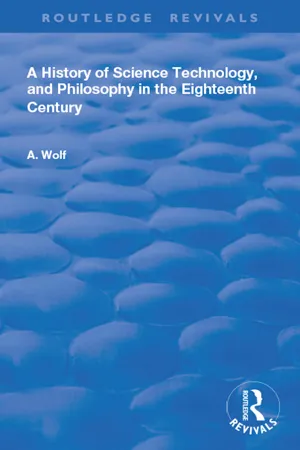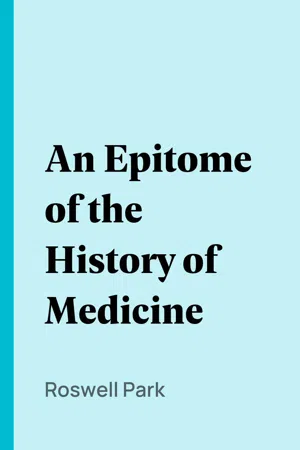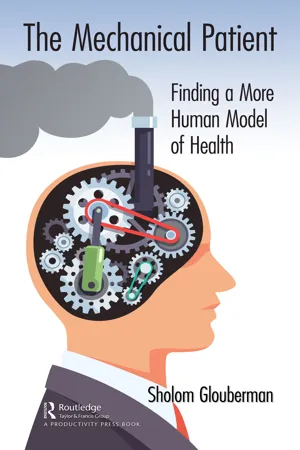History
John Hunter
John Hunter was an 18th-century Scottish surgeon and anatomist known for his pioneering work in surgery, anatomy, and pathology. He made significant contributions to the understanding of venereal disease, inflammation, and wound healing. Hunter's meticulous observations and experiments laid the foundation for modern surgical techniques and medical knowledge.
Written by Perlego with AI-assistance
4 Key excerpts on "John Hunter"
- eBook - ePub
Medical Theory, Surgical Practice
Studies in the History of Surgery
- Christopher Lawrence(Author)
- 2018(Publication Date)
- Routledge(Publisher)
5Physiological principles in the surgical writings of John Hunter
Stephen JacynaIntroductionSince the turn of the nineteenth century John Hunter has been presented as the father of scientific surgery. An influential and persistent historiographic tradition has maintained that Hunter was the first to grasp that surgical practice did not rest upon clinical experience alone, but that it must also be informed by a knowledge of physiological and pathological principles if it were to attain its full potential.1 Hunter himself said as much in the introduction to his lectures on surgery. At the outset he rejected the usual course of treating particular diseases and operations, ‘these being taught by Anatomists and others — The principles are what are the most necessary and these shall be the object of our inquiry.’2 Without a sound knowledge of such principles, Hunter declared, ‘a man cannot be a surgeon’.3 Recent studies of Hunter have tended to consider his physiological theories in the abstract — as one thread in the varied texture of bio-medical thought at the end of the eighteenth century.4 This is to overlook the instrumental character that Hunter himself ascribed to his physiology: the primary use of such knowledge was the improvement of the art of surgery. It is also to ignore the dominant image of Hunter’s significance that has been handed down to succeeding generations of surgeons. In this essay I shall ask whether there are, indeed, discernible areas of interaction between Hunter’s theory and his practice. Was he truly a ‘scientific surgeon’; or is there a discontinuity between Hunter the physiologist and Hunter the medical practitioner?Theory and practice in eighteenth-century surgeryIt was a common stratagem among Hunter’s eulogists to portray pre-Hunterian surgery as (with a few honourable exceptions) purely ‘empirical’ in character, in contrast to the ‘scientific’ approach of the post-Hunterian era. It is certainly possible to find bluff assertions of the superiority of knowledge gained by experience over any form of theory in surgical texts of the eighteenth century. In 1765 the Irish surgeon Sylvester O’Halloran denounced previous surgeons who had relied upon their theoretical preconceptions when formulating therapy; ‘by admitting a theory, repugnant to experience, in most instances, have conclusions been drawn, highly detrimental to the sick, and to surgery!’ The diversity and complexity of the phenomena which daily confronted the surgeon proved ‘the futility of attempting to draw general conclusions, from particular experiments’, and supplied ‘concise and cogent reasons’ for rejecting ‘general systems, either of physic, or philosophy’.5 Edward Alanson in 1782 boasted in similar vein that ‘Since all speculative reasoning on these [surgical] subjects is very fallacious, when placed in competition with experience, it has been my aim to deduce the doctrine of this work from practice only.’6 It is worth noting that even a ‘post-Hunterian’ surgeon could in 1814 consider it ‘mortifying to the pride of theory to see how often it is humbled before the conviction of practice’.7 - Abraham Wolf(Author)
- 2019(Publication Date)
- Routledge(Publisher)
Lectures and Observations on Medicine, 1825, pp. 84–7).Hunter was, however, much more than a pathologist; he was a student of natural history to whom the study of disease was but a special aspect of biology. It is to John Hunter that we owe the attempt to make of medicine a systematic study to which the physician and surgeon can both contribute.One of his experiments was of special interest for the light it threw on an adjustment in the blood circulation, which proved to be of considerable importance for surgery. The experiment was performed on a deer. By ligaturing an artery supplying the growing antlers, he cut off their blood supply, and they became cold. In the course of a few days, their temperature rose again to normal, suggesting that blood had somehow once more entered the antlers; and dissection showed that a compensatory collateral circulation had been established in place of the ligatured artery, which had completely withered. The discovery is interesting from a purely biological point of view, but it also has a medical application, which Hunter himself was able to see. In the case of an aneurysm, for instance, the artery affected by the dilation, or by a blood clot, may be ligatured, and the circulation will soon be maintained by the establishment of a compensatory branch from the artery, while the ligatured artery and its disorder will disappear. Hunter made use of his own discovery, and introduced surgical treatment on these lines, successfully operating for popliteal aneurysm.WILLIAM HUNTER When John Hunter arrived in London, in 1748, his brother, William Hunter, was already established there as a distinguished surgeon and anatomist.William Hunter was born in Scotland, in 1718; he was destined for the Church, but early showed a dislike for this calling, and, coming under the influence of Cullen, was persuaded to take up the study of medicine. It was with Cullen that he began his life’s work; but after a time it was arranged “that Hunter should go to prosecute his medical studies at Edinburgh and London, and afterwards return to settle at Hamilton in partnership with Cullen” (Peachey, William and John Hunter- eBook - ePub
- Roswell Park(Author)
- 2014(Publication Date)
- Perlego(Publisher)
As already noted, the surgeons of the eighteenth century were often obstetricians,—William Hunter conspicuously. The most important obstetrician of his time was William Smellie (1680-1763), of London, who invented numerous instruments, wrote a large treatise on the theory and practice of midwifery, and greatly advanced our knowledge of deformed pelves. He was the first to distinguish one diameter from the other, and to point out the importance of cephalic version and version of the breech. Parenthetically, it may be remarked that William Hunter, great as he was, was the uncompromising foe of instrumental midwifery, and was in the habit of showing his forceps, covered with rust, as evidence that he never resorted to such aids. A rival of Smellie and Hunter was Thomas Denman (1753-1815), best known, perhaps, because of his demonstration of the portability of puerperal infection.The researches of anatomists during the eighteenth century were, for the most part, directed toward the minute, more difficult, and less striking parts, and to increased thoroughness and accuracy of description. Microscopical anatomy suffered a relative quiescence. Pathological and general anatomy, which were destined to control the medicine of the succeeding century, were newly created and not yet regarded as sciences by themselves, but merely as special branches. The most important feature was the revival and more accurate study of experimental physiology, which had been scarcely resorted to since the time of Galen, except for Harvey's discoveries. This revival, which really seemed an epoch in the history of medicine, was effected by the great Haller (1708-1777), of Berne,—a man who really deserved the title of "Great," as he was a universal and indefatigable savant, possessed of thorough conscientiousness, marvelous capacity for work, great ingenuity, natural endowments, and an inextinguishable love for art and science; he was certainly one of the most versatile scholars and thinkers of any time, distinguished not only in his chosen field of medicine, but as a poet, botanist, and statesman. Like all Swiss poets, he never passed beyond the didactic and the homely in his versification. From his tenth year he wrote poems in Latin and German, and even when eight years old had made most extensive compilations from Bayle's dictionary. At fifteen he went to the University of Tubingen, where, in the second year of his sojourn, he disputed with one of his teachers. In 1725 he went to Leyden, where Boerhaave and Albinus found in him a most indefatigable follower. At nineteen he received the degree of doctor. In the excess of his zeal for anatomy he purchased for a considerable sum, from Albinus, half of a corpse, the other half of which his teacher had dissected; and, while in Paris, he even engaged in grave-robbing, and, being betrayed by his own carelessness, was compelled to save himself by flight. In many other States, and in more than one country, he studied with the best of teachers, lecturing at times himself. At the age of twenty-six he became professor and hospital director at Berne, and in 1752 published his famous researches on irritability. Three years later he accepted a call to Gottingen as Professor of Anatomy, Surgery, Chemistry, and Botany. He was the founder of a botanical garden; for many years was so busy that he slept and lived in his library; and, in spite of his enormous and unique correspondence with the savants - eBook - ePub
The Mechanical Patient
Finding a More Human Model of Health
- Sholom Glouberman(Author)
- 2018(Publication Date)
- Productivity Press(Publisher)
Throughout the centuries, wars and army service provided an opportunity for surgeons to develop their mechanical skills and knowledge. Individual surgeons became skilled at particular procedures and trained their apprentices to perform and improve them over generations. Amputations during war were well known but other procedures like the excision of bladder stones, and the draining of abscesses were also practiced. Surgeons adept at a particular procedure became specialized as they are today. Surgical skills advanced more rapidly after human dissection initiated the modern mechanical understanding of the body.The development of modern surgery begins with a better understanding of human anatomy and develops through the introduction of anesthesia and antiseptic procedures. These steps led to the need for a modern hospital and at the same time deepened and confirmed the mechanical account of the body.John Hunter (1728–1793)After Boyle, schools of anatomy flourished. Galen, who had dissected only animals, was shown to be mistaken about the many organs which differ between humans and animals. Cadavers were bought, stolen and sold. Researchers and medical students were always at the scene of public executions to gain access to bodies immediately after death. If the body is mechanical then one body is pretty much like others: they have the same muscles, organs and bones. The unique individual in humoral medicine was gradually supplanted by the standardized mechanical patient. The aim was to gain knowledge of the mechanical body and treatments that could be turned into clear protocols.John Hunter was one of the founders of modern surgery. He studied human anatomy with his elder brother William, developed his skills as an army surgeon during the Seven Years War, and later opened a museum of specimens and an anatomy school in his house in London. Some of the advances that emerged from human dissection included better instruments and faster procedures. The speed of procedures was critical because surgeries were performed without anesthetic. As their skills improved, surgeons separated themselves from barbers to form a Company of Surgeons in 1745. Despite advances, the lack of anesthetic and little understanding of antiseptic measures made surgery dangerous, painful and often fatal.
Index pages curate the most relevant extracts from our library of academic textbooks. They’ve been created using an in-house natural language model (NLM), each adding context and meaning to key research topics.
Explore more topic indexes
Explore more topic indexes
1 of 6
Explore more topic indexes
1 of 4



